Nothing beats the comfort of Jamaican bully beef when you’re craving a hearty and satisfying meal that’s ready in minutes. This beloved Caribbean dish transforms humble canned corned beef into a flavorful feast that’ll have your taste buds dancing with every bite. We’ve perfected this traditional recipe that Jamaican families have been enjoying for generations.
What makes our version special is the perfect blend of aromatic onions, vibrant bell peppers, and that signature kick of scotch bonnet pepper that gives it authentic island flavor. The beauty of bully beef lies in its simplicity – you probably have most ingredients in your pantry right now.
Whether you’re serving it with rice and peas, fried plantains, or fresh bread, this protein-packed dish delivers maximum flavor with minimal effort. Let’s jump into creating this soul-warming Jamaican classic that’ll become your new weeknight dinner hero.
What Is Jamaican Bully Beef
Jamaican bully beef transforms humble canned corned beef into a flavorful Caribbean staple that graces dinner tables across the islands. We recognize this dish as more than just a simple meal – it represents resourceful cooking that maximizes flavor from affordable ingredients.
The term “bully beef” originates from the French “bouilli” meaning boiled beef, which evolved through Caribbean culinary history. Canned corned beef serves as the protein foundation, while aromatic vegetables and spices create the signature taste profile that defines authentic Jamaican cooking.
Our traditional preparation method involves sautéing onions, bell peppers, and tomatoes until they develop deep caramelized flavors. These vegetables form the sofrito base that distinguishes Jamaican bully beef from other corned beef preparations worldwide.
Fresh herbs like thyme and scallions infuse the dish with garden-fresh brightness. Scotch bonnet peppers add heat levels that range from mild warmth to fiery intensity, depending on personal preference and pepper preparation methods.
The cooking technique breaks down the canned meat’s dense texture while absorbing surrounding flavors. Salt fish and ackee might dominate Jamaican breakfast conversations, but bully beef holds its ground as a versatile protein that works equally well for lunch or dinner.
Regional variations exist throughout the Caribbean, yet the Jamaican version maintains distinct characteristics. Some families incorporate curry powder for golden color and warm spice notes, while others prefer the natural beef flavor enhanced only by vegetables and herbs.
This comfort food bridges economic accessibility with satisfying nutrition. Working families appreciate how quickly the dish comes together after long days, while the robust flavors satisfy cravings for authentic Caribbean tastes without extensive ingredient shopping or complicated preparation techniques.
Ingredients

Our authentic Jamaican bully beef recipe requires simple pantry staples and fresh vegetables that create bold Caribbean flavors. We’ve organized the ingredients by category to help you prepare this comforting dish efficiently.
For the Bully Beef
- 1 can corned beef (also called bully beef in Jamaica)
For the Vegetables
- 1 medium onion (diced or sliced)
- 1 medium ripe tomato (chopped or diced)
- ¼–½ green, red, or bell pepper (sliced or diced)
- 2 stalks scallion/spring onion (chopped, optional)
- 2 garlic cloves (chopped, optional)
- ½–1 scotch bonnet pepper (de-seeded and minced; adjust for heat)
- 100g sweetcorn (optional)
Seasonings and Spices
- ½ tsp–1 tsp black pepper
- ½ tsp salt (optional)
- 2–4 sprigs fresh thyme
- 1 tbsp ketchup or 4 tbsp tomato ketchup
- 1 tbsp vegetable, coconut, or canola oil
- 1 tsp browning sauce (optional)
Equipment Needed
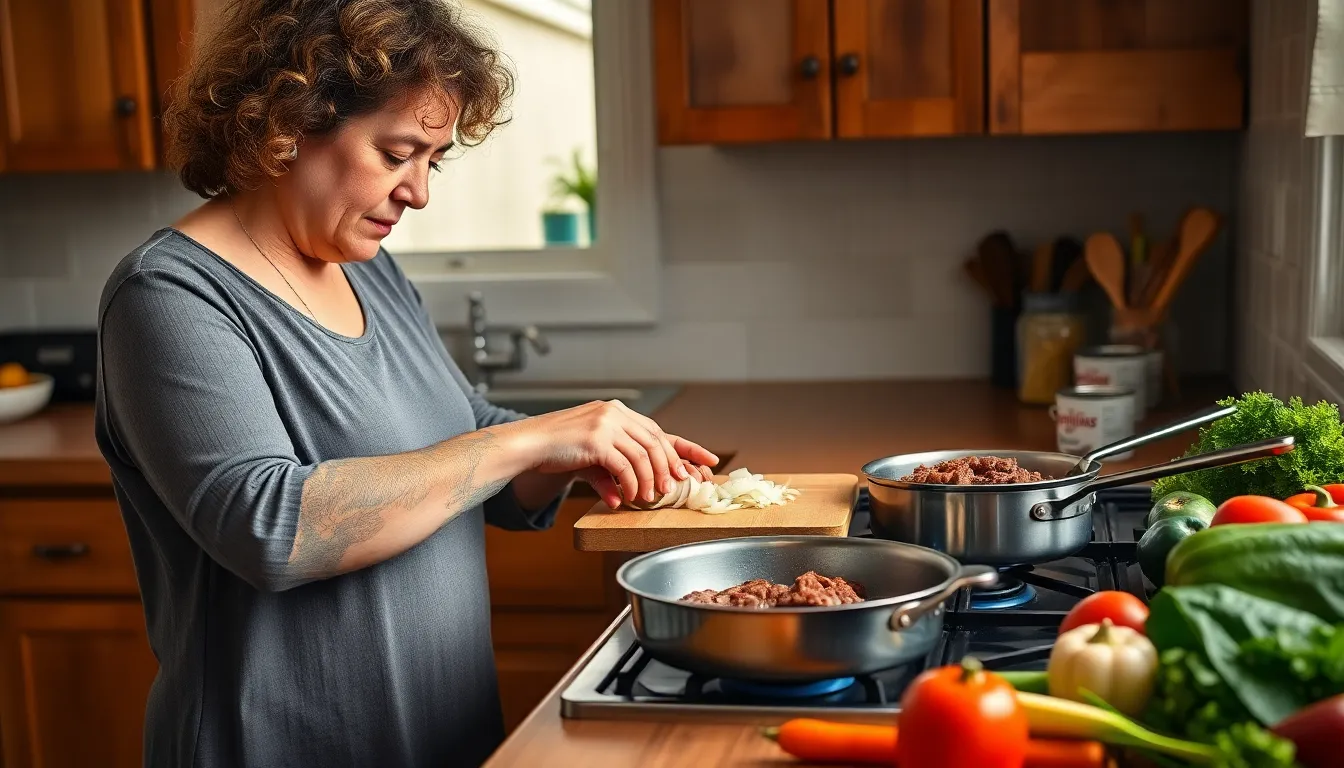
Making authentic Jamaican bully beef requires minimal kitchen equipment, making this dish accessible to home cooks with basic culinary tools. We focus on essential items that ensure proper preparation and cooking techniques for optimal flavor development.
Essential Cooking Equipment:
- Medium skillet or frying pan (stainless steel or cast iron preferred)
- Large spoon or spatula for stirring and breaking up meat
- Sharp knife for precise vegetable cutting
- Cutting board (preferably separate for vegetables)
- Can opener for accessing canned corned beef
Preparation Tools:
- Medium mixing bowl for organizing ingredients
- Small prep bowls for measured seasonings
- Kitchen towel for cleanup during cooking
The medium skillet serves as our primary cooking vessel, providing adequate surface area for sautéing vegetables and properly heating the corned beef. Cast iron skillets work exceptionally well for this recipe because they retain heat evenly and develop those coveted caramelized flavors in the sofrito base.
Our sharp knife becomes crucial for achieving uniform vegetable cuts that cook evenly. Properly diced onions and tomatoes create the foundation of authentic Jamaican bully beef, while consistent cutting ensures balanced flavors throughout the dish.
The large spoon or spatula allows us to break down the canned corned beef effectively, transforming its compact texture into tender, well-seasoned pieces that absorb the aromatic vegetable flavors. This tool also helps us combine ingredients without mashing the delicate tomatoes or overcooking the vegetables.
Most home kitchens already contain these basic tools, making Jamaican bully beef an approachable recipe for cooks at any skill level. The simplicity of required equipment reflects the dish’s humble origins as a practical meal solution during challenging times.
Prep Work
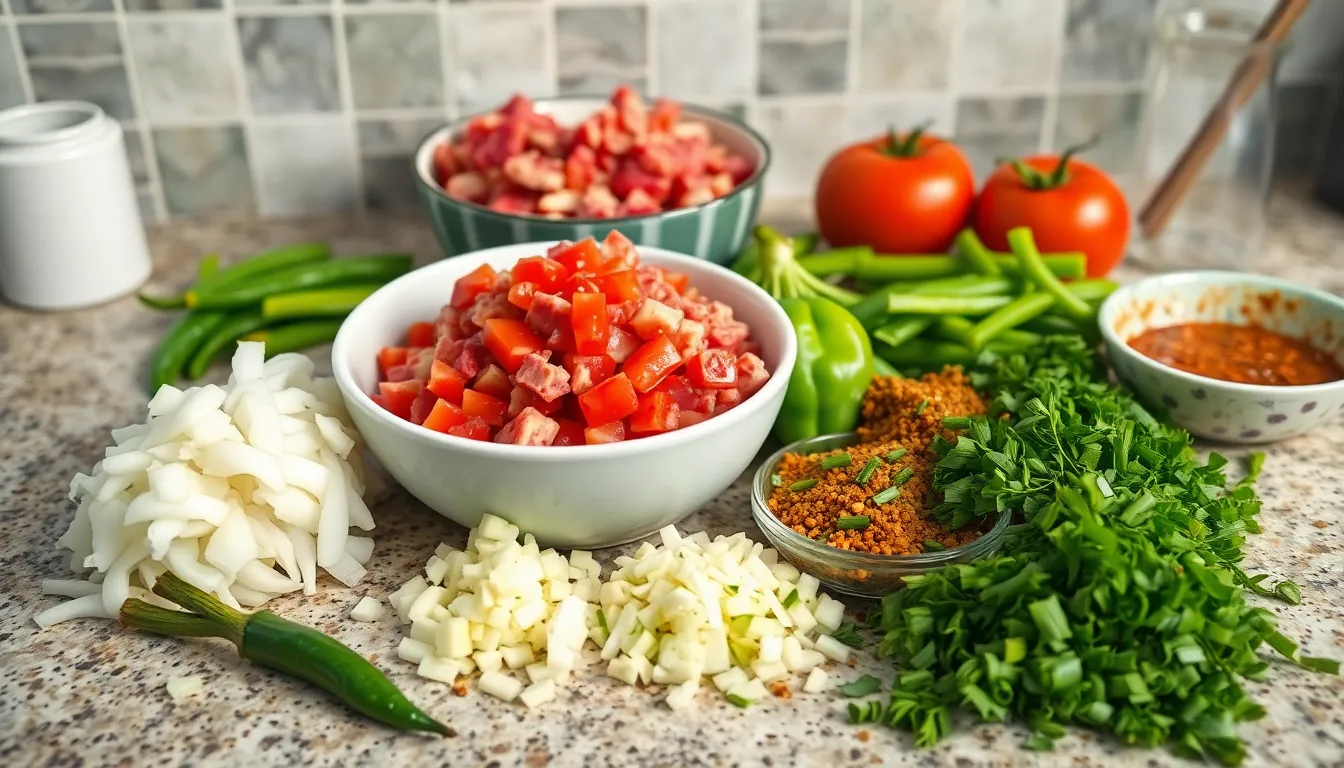
We begin our Jamaican bully beef preparation by organizing all ingredients and completing the essential prep work that ensures smooth cooking. This systematic approach allows us to focus on developing the perfect balance of flavors when we start cooking.
Preparing the Vegetables
We start by opening the can of corned beef using the provided key or a standard can opener. Remove the beef completely with a fork or spoon and set it aside in a bowl for later use.
Next we slice one medium onion into either rings or large dice pieces depending on your texture preference. Dice one medium ripe tomato into chunky pieces that will break down during cooking while maintaining some texture. Slice the quarter green bell pepper into strips if you choose to include this optional ingredient.
We carefully mince half a scotch bonnet pepper for authentic Caribbean heat. Remove the seeds if you prefer less spiciness but want to maintain the pepper’s distinctive flavor. Chop two stalks of scallion into small rings and strip the leaves from two sprigs of fresh thyme by running your fingers along the stems.
Preparing the Seasonings
We measure out one tablespoon of vegetable oil or canola oil for sautéing our aromatics. Set aside one tablespoon of ketchup which adds moisture and a subtle tang to balance the saltiness of the corned beef.
Measure half a teaspoon of black pepper for seasoning depth. If using browning sauce we portion out one teaspoon which will enhance both color and add a hint of caramelized flavor to our finished dish.
Having all seasonings pre-measured in small bowls prevents any delays during the cooking process and ensures we achieve the authentic taste profile that makes Jamaican bully beef so beloved.
Instructions
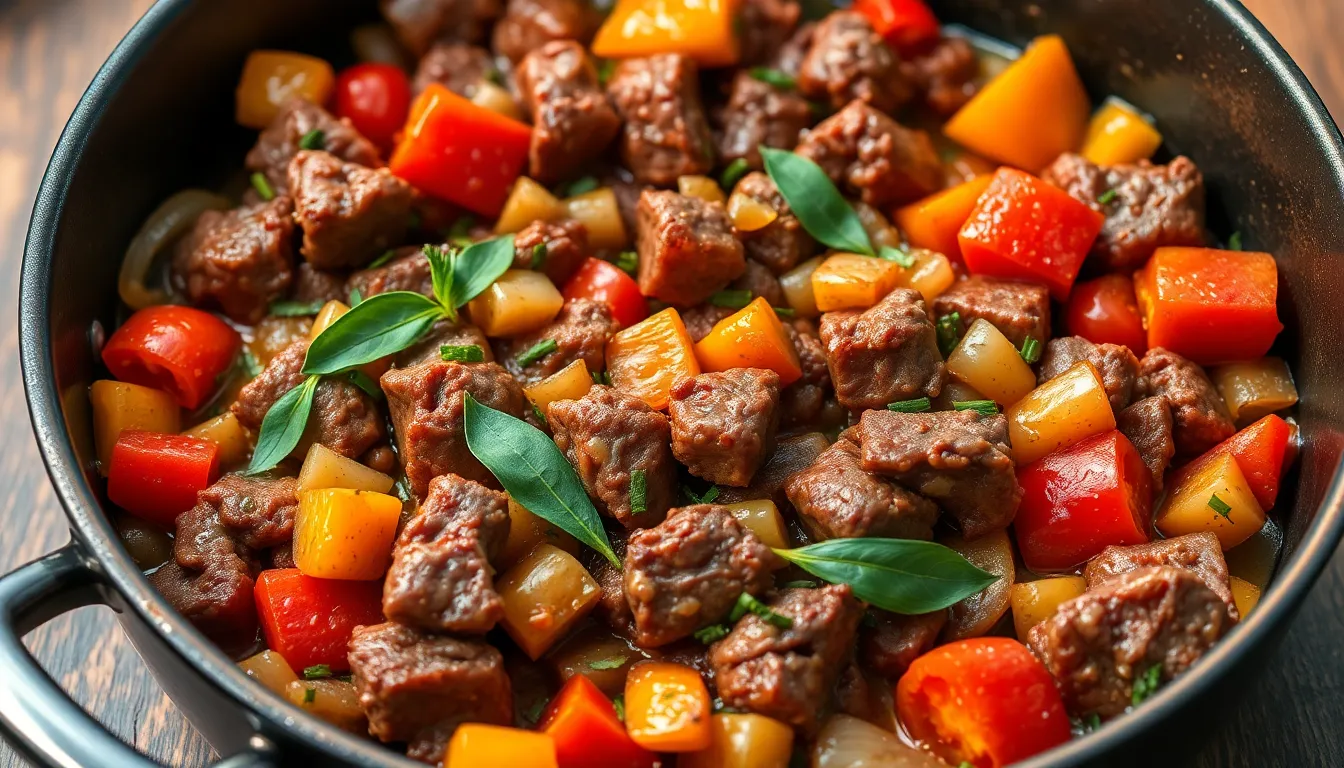
Now that we have our ingredients prepped and equipment ready, let’s transform our simple canned corned beef into an authentic Jamaican bully beef. The key to success lies in building layers of flavor through careful timing and technique.
Step 1: Prepare the Bully Beef
We begin by opening our can of corned beef and removing it completely using a fork or spoon. Transfer the entire contents to a clean plate or bowl, keeping it intact for now. We’ll break it down later during the cooking process to achieve the perfect texture. Set the corned beef aside at room temperature while we prepare our aromatic base.
Step 2: Sauté the Aromatics
Heat 1 tablespoon of oil in our medium skillet over medium heat until it shimmers slightly. Add the sliced onions first, stirring them gently to coat with oil. Cook for about 30 seconds before adding the minced scotch bonnet pepper, garlic, and fresh thyme leaves. We want the onions to become translucent and fragrant, which takes approximately 1 to 2 minutes. The aromatics should sizzle gently without browning too quickly.
Step 3: Add Vegetables
Introduce the diced tomatoes to our aromatic base, stirring them in carefully to prevent splattering. Add the sliced bell pepper and chopped scallions if using, allowing these vegetables to soften and release their flavors. Cook this mixture for 2 to 3 minutes, stirring occasionally to prevent sticking. The tomatoes should begin to break down slightly and create a light sauce base.
Step 4: Combine and Season
Add our prepared corned beef to the skillet, using a large spoon to break it apart into chunks of your preferred size. Some families prefer finely shredded beef while others enjoy chunkier pieces. Stir in the black pepper, ketchup for subtle sweetness, and browning sauce if desired for deeper color and flavor. Mix all ingredients thoroughly, ensuring the beef absorbs the vegetable mixture and seasonings evenly.
Step 5: Final Cooking
Reduce heat to medium low and continue cooking for 3 to 5 minutes, stirring occasionally to prevent sticking. The beef should lose its solid canned form and integrate completely with our vegetable base. We can remove any excess oil that surfaces by dabbing it with a paper towel. Taste and adjust seasoning with additional black pepper or salt if needed. Serve immediately while hot alongside rice, boiled green bananas, or fresh bread for an authentic Jamaican experience.
Serving Suggestions
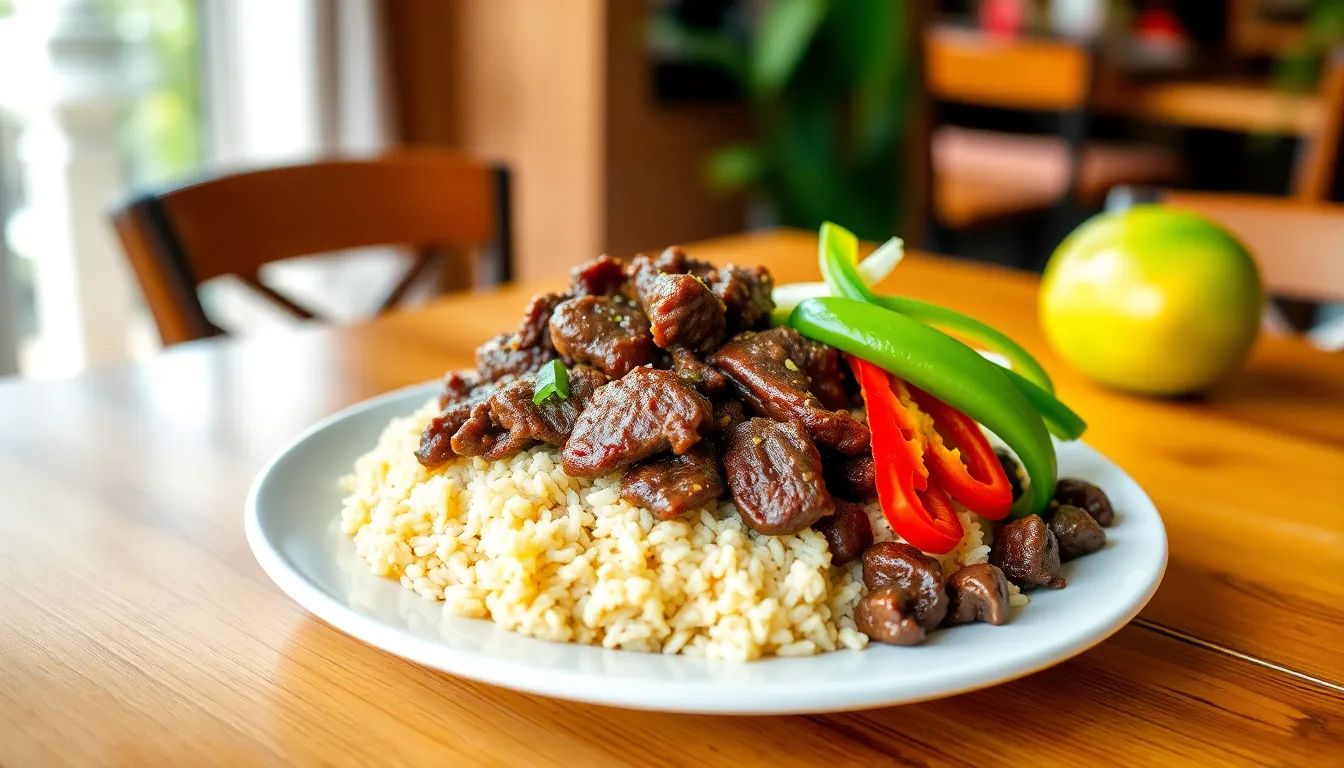
We love how versatile Jamaican bully beef becomes when paired with the right accompaniments. The dish transforms from a simple weeknight meal into an authentic Caribbean feast with these traditional and modern serving options.
Traditional Pairings
White rice stands as the most beloved foundation for our bully beef, creating the perfect canvas for the savory flavors to shine. We recommend serving generous portions over steamed jasmine or long-grain white rice, allowing the aromatic juices to soak into every grain.
For breakfast presentations, we pair our bully beef with johnny cakes, boiled green bananas, or buttered toast. These morning combinations provide satisfying carbohydrates that complement the protein-rich corned beef perfectly.
Boiled dumplings offer another classic pairing that we frequently enjoy, especially when seeking a heartier meal. We also love serving the dish alongside fried plantains, which add natural sweetness that balances the savory and spicy elements beautifully.
Ground provisions like yam and sweet potato create authentic Caribbean combinations that our families have treasured for generations. These starchy vegetables provide earthy flavors that enhance the overall dining experience.
Modern Twists
We incorporate cooked pasta into our bully beef for contemporary fusion meals that appeal to diverse palates. Penne or rotini work exceptionally well, as their shapes capture the flavorful sauce components effectively.
Adding fresh cabbage during the final cooking stages creates additional texture and nutritional value. We sauté thin cabbage strips until just tender, maintaining some crunch for visual and textural contrast.
Bell peppers and carrots expand the vegetable profile while introducing vibrant colors to our presentations. These additions cook quickly and provide extra nutrients without overwhelming the traditional flavor profile.
We experiment with different spice blends while maintaining the core taste elements of savory, slightly sweet, and spicy characteristics. Curry powder additions create warming notes, while extra scotch bonnet increases heat levels for those who prefer more intense flavors.
Serving our bully beef in tortillas as Caribbean-inspired wraps offers portable meal options. We add fresh lettuce, diced tomatoes, and a squeeze of lime for bright, contemporary presentations.
Storage and Reheating
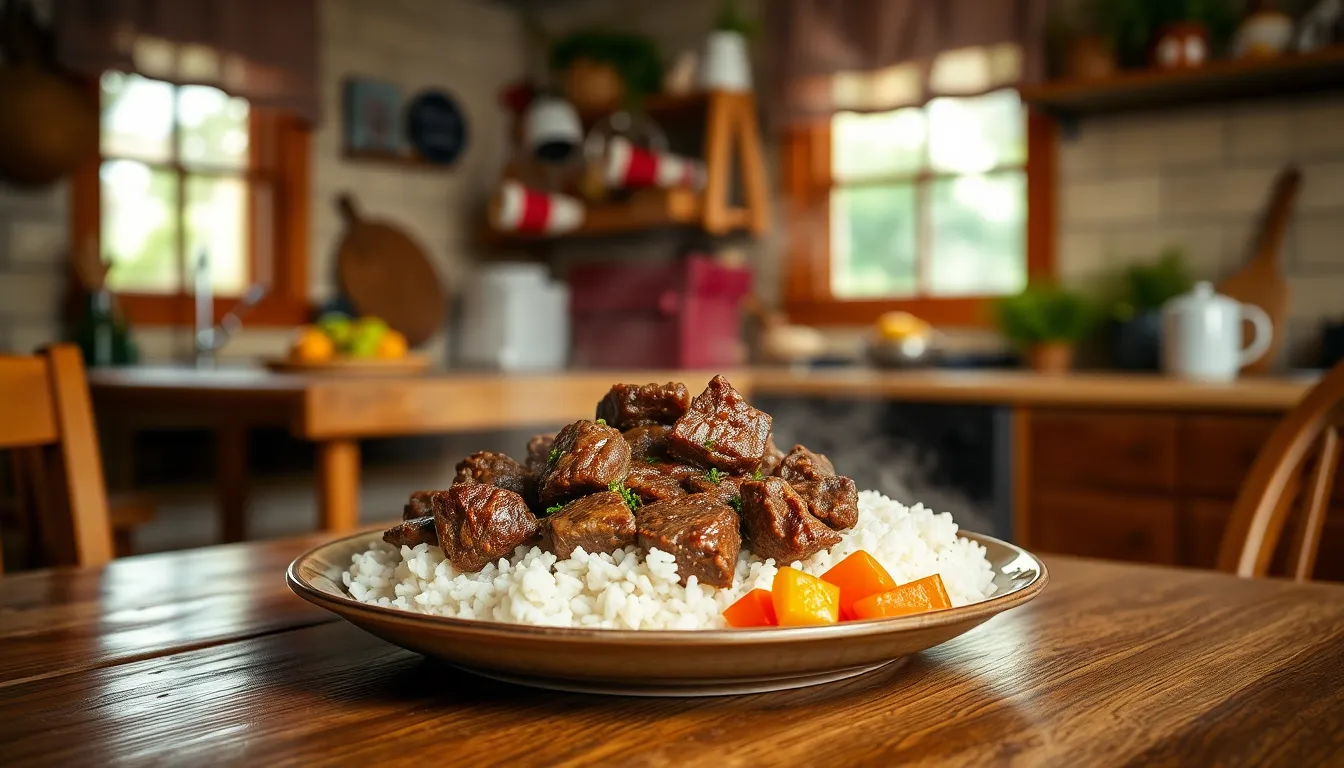
We always recommend storing leftover Jamaican bully beef in an airtight container in the refrigerator to maintain its vibrant flavors and prevent contamination. Our experience shows that properly stored bully beef remains fresh and safe for consumption within 3-4 days when refrigerated promptly after cooking.
Temperature control plays a crucial role in food safety. We advise against leaving cooked bully beef at room temperature for extended periods as this creates ideal conditions for bacterial growth. The dish should be transferred to refrigerated storage within two hours of cooking to ensure optimal safety standards.
| Storage Method | Duration | Temperature |
|---|---|---|
| Refrigerator | 3-4 days | Below 40°F |
| Room Temperature | Maximum 2 hours | Not recommended |
Stovetop Reheating Method
We prefer reheating bully beef on the stovetop over medium heat for the best texture and flavor retention. Our method involves stirring the dish occasionally to ensure even heating throughout while preventing any burning or sticking to the pan.
Moisture levels can decrease during storage. We recommend adding a splash of water or a small amount of vegetable oil if the mixture appears dry during the reheating process. This technique helps restore the original consistency and prevents the beef from becoming tough or overcooked.
Microwave Reheating Option
Microwave reheating offers convenience for quick meals. We suggest using a microwave-safe dish and heating the bully beef in intervals while stirring halfway through the process to ensure uniform temperature distribution.
Safety remains our top priority during reheating. We always ensure the dish reaches a steaming hot temperature before serving to eliminate any potential foodborne pathogens that may have developed during storage. The internal temperature should be thoroughly heated throughout rather than just warmed on the surface.
Recipe Variations

We love experimenting with different versions of this classic dish to suit varying taste preferences and dietary needs. These popular variations showcase the versatility of Jamaican bully beef while maintaining its authentic Caribbean character.
Spicy Bully Beef
Heat lovers will appreciate this fiery version that amplifies the scotch bonnet pepper’s natural intensity. We increase the scotch bonnet pepper quantity from ½ to 1 full pepper for those who crave serious heat. Fresh garlic cloves get minced and sautéed alongside the onions to build deeper aromatic layers.
Additional black pepper gets incorporated during the sautéing process to create multiple heat dimensions throughout the dish. Some families add curry powder during the vegetable stage for warmth and complexity. Hot sauce enthusiasts can drizzle their favorite Caribbean hot sauce directly into the skillet before the final cooking stage.
We recommend tasting as you go when building heat levels since scotch bonnet peppers vary significantly in their spiciness. This variation pairs exceptionally well with cooling sides like coconut rice or sweet fried plantains to balance the intense flavors.
Bully Beef with Callaloo
This nutritious variation incorporates Jamaica’s beloved leafy green vegetable for added health benefits and vibrant color. We chop fresh callaloo leaves and add them to the skillet with the onions and peppers during the initial sautéing stage. The callaloo wilts quickly and absorbs the aromatic flavors while contributing its own mild earthy taste.
Frozen callaloo works perfectly when fresh leaves aren’t available and should be thawed and drained before adding to the pan. We cook the callaloo just until it brightens in color and softens slightly to preserve its nutritional value and prevent overcooking.
This combination creates a more balanced meal by pairing the salty richness of corned beef with the mineral rich greens. The callaloo adds visual appeal with its deep green color contrasting beautifully against the rich brown tones of the seasoned beef. We often serve this version with plain white rice to let the vegetable flavors shine through.
Tips for Perfect Jamaican Bully Beef

Mastering the timing of your vegetable cooking creates the foundation for exceptional bully beef. We sauté onions and bell peppers until they become translucent and release their natural aromatics before introducing the corned beef. This technique prevents overcooking the meat while ensuring our vegetables develop their full flavor potential.
Breaking apart the corned beef requires deliberate consideration based on your texture preferences. Some families prefer chunky pieces that maintain bite and substance throughout the dish. Others break the meat into smaller shreds that integrate seamlessly with the vegetables and absorb more of the surrounding flavors.
Temperature control becomes crucial when working with canned corned beef since this processed meat can quickly turn tough and rubbery. We cook just long enough to heat the beef through and allow it to absorb the aromatic base. Overcooking transforms the tender texture into an unpleasant chewiness that diminishes the entire dish.
Adding vegetables like cooked cabbage expands both nutrition and flavor complexity in your bully beef. We incorporate these extras during the vegetable sautéing stage before adding the corned beef. This timing ensures proper cooking without creating mushy textures that compromise the dish’s appeal.
Moisture and flavor enhancers like ketchup or browning sauce serve dual purposes in authentic Jamaican bully beef. The ketchup provides subtle sweetness and tanginess that balances the saltiness of the canned meat. Browning sauce adds rich color depth and umami notes that elevate the overall taste profile.
Serving accompaniments significantly impact how your bully beef satisfies and nourishes. Traditional pairings with white rice or dumplings create hearty meals that showcase Caribbean comfort food traditions. Plantains and ground provisions like yam or sweet potato add authentic touches that honor the dish’s cultural origins.
Emergency preparedness makes this recipe particularly valuable since canned corned beef maintains long shelf life without refrigeration. We recommend keeping ingredients stocked for quick meals during hurricanes or other challenging situations when fresh options become limited.
Conclusion
We’ve shared everything you need to master this beloved Caribbean comfort food that transforms simple canned corned beef into something truly special. This recipe proves that delicious authentic meals don’t require expensive ingredients or complicated techniques.
Whether you’re looking for a quick weeknight dinner or want to explore Caribbean flavors we’re confident this Jamaican bully beef will become a regular in your meal rotation. The versatility of this dish means you can adapt it to your family’s preferences while keeping those essential island flavors intact.
Now it’s time to head to your kitchen and experience the satisfaction of creating this flavorful traditional dish. Your taste buds will thank you for bringing a piece of Jamaica to your dining table.
Frequently Asked Questions
What is Jamaican bully beef?
Jamaican bully beef is a traditional Caribbean dish made from canned corned beef that’s transformed into a flavorful meal. The name “bully beef” comes from the French word “bouilli,” meaning boiled beef. It features a sofrito base of sautéed onions, bell peppers, and tomatoes, enhanced with herbs like thyme and scotch bonnet peppers for authentic Caribbean flavor.
How long does it take to make Jamaican bully beef?
Jamaican bully beef is a quick and easy dish that typically takes about 15-20 minutes to prepare and cook. The preparation involves chopping vegetables and organizing ingredients, while the actual cooking process focuses on sautéing aromatics and combining ingredients. This makes it perfect for busy weeknight dinners when you need a satisfying meal fast.
What ingredients do I need for authentic Jamaican bully beef?
Essential ingredients include canned corned beef, onions, tomatoes, bell peppers, fresh thyme, scotch bonnet pepper, ketchup, black pepper, and cooking oil. Optional additions include scallions, garlic, sweetcorn, and browning sauce. The combination of these fresh vegetables and seasonings creates the authentic Caribbean flavor profile that makes this dish special.
What can I serve with Jamaican bully beef?
Jamaican bully beef pairs wonderfully with steamed rice, rice and peas, fried plantains, or fresh bread. For breakfast, serve it with johnny cakes, boiled green bananas, or buttered toast. You can also enjoy it with boiled dumplings, ground provisions like yam and sweet potato, or create modern wraps using tortillas with fresh vegetables.
How do I store leftover Jamaican bully beef?
Store leftover bully beef in an airtight container in the refrigerator for 3-4 days. Make sure to refrigerate promptly after cooking and avoid leaving it at room temperature for extended periods. For reheating, use the stovetop method for best results, adding a little moisture if needed, or microwave while ensuring the dish reaches steaming hot temperature.
Can I make variations of this recipe?
Yes, Jamaican bully beef is highly versatile. You can make a spicier version by adding more scotch bonnet pepper and minced garlic. Add callaloo or cooked cabbage for extra nutrition and flavor. Some families incorporate curry powder for warmth, while others add cooked pasta for a modern twist. The dish adapts well to different taste preferences.
What kitchen equipment do I need?
You’ll need basic kitchen equipment: a medium skillet (preferably cast iron), a large spoon or spatula, sharp knife, cutting board, and can opener. Additional prep tools like mixing bowls and small bowls for seasonings are helpful. The simplicity of required equipment reflects the dish’s humble origins and makes it accessible for any skill level.







